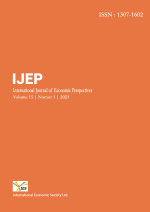Application of Association Rule Mining in Banking Sector
Abstract
In the present age of globalization, data is considered as most important asset of an organization. But the irony of the situation is that, we are becoming data rich and information poor i.e we have collected a huge amount of data, but are not able to get the required information out of it. The organizations which will be able to convert their data into knowledge and hence will be able to use it for the decision making will rule the world. So the techniques of data mining are proving to be a boon in such context. Data mining is an emerging field and it helps to find out interesting patterns and knowledge from the large amount of data in the transactional and interpersonal database. One of the most important data mining technique is association rule mining whose main purpose is to find frequent patterns, associations and relationship between various database items using different Algorithms. The present paper explores the use of this technique in banking sector. The data collected from the employees of public and private sector banks has been analyzed by applying association rule mining to find the association between the educational qualifications of employee and their readiness to adopt the data mining techniques.
References
C. Angeli, S. K. Howard, J. Ma, J. Yang, and P. A. Kirschner, “Data mining in educational technology classroom research: Can it make a contribution?,” Comput. Educ., vol. 113, pp. 226–242, 2017.
M. Zechner and W. Kienreich, “Scalable realtime glyph rendering on consumer level graphics hardware: A hybrid approach,” in Proceedings of the 7th IASTED International Conference on Visualization, Imaging, and Image Processing, VIIP 2007, 2007.
A. Houari, W. Ayadi, and S. Ben Yahia, “Mining Negative Correlation Biclusters from Gene Expression Data using Generic Association Rules,” Procedia Comput. Sci., vol. 112, pp. 278–287, 2017.
Behrouz Minaei-Bidgoli, Elham Akhondzadeh- A New Approach of Using Association Rule Mining in Customer Complaint Management- IJCSI, International Journal of Computer Science Issues, Vol. 7, Issue 5, September 2010
A.Vasudevan, “Report of the Committee on Technology Up gradation in the Banking Sector”, Constituted by Reserve Bank of India, Chairman of Committee, 1999
P.Isakki alias Devi, S.P.Rajagopalan- Analysis of Customer Behavior using Clustering and Association Rules.
R. Agrawal, and R. Srikant, "Fast algorithm for mining association rules", In Proceedings of the Twentieth International Conference on Very Large Databases, 1994, pp. 487–499.
Bharati M. Ramageri [2010]-Data Mining Techniques and Applications- Indian Journal of Computer Science and Engineering- Vol. 1 No. 4 301-305.
Madan Lal Bhasin, “Data Mining: A Competitive Tool in the Banking and Retail Industries”, The Chartered Accountant October 2006
J. Han, J. Pei, and M. Kamber, Data Mining: Concepts and Techniques. Elsevier Science, 2011.
P. Tan, M. Steinbach and V. Kumar, "Introduction to Data Mining", Addison Wesley, ISBN: 0-321-32136-7, 2006.
J. Han and M. Kamber, Data Mining: "Concepts and Techniques, Second Edition", Morgan Kaufman Publisher,2006.
Hillol Kargupta, Anupam Joshi, Krishnamoorthy Siva Kumar, Yelena Yesha, "Data Mining: Next Generation Challenges and Future Directions", Publishers: Prentice-Hall of India, Private Limited, 2005.
B. Desai and Anita Desai, "The Role of Data mining in Banking Sector", IBA Bulletin, 2004.
S.S.Kaptan, “New Concepts in Banking”, Sarup and Sons, Edition, 2002
Rajanish Dass, "Data Mining in Banking and Finance: A Note for Bankers", Indian Institute of Management Ahmadabad.
Published
How to Cite
Issue
Section
Allows users to: distribute and copy the article; create extracts, abstracts, and other revised versions, adaptations or derivative works of or from an article (such as a translation); include in a collective work (such as an anthology); and text or data mine the article. These uses are permitted even for commercial purposes, provided the user: gives appropriate credit to the author(s) (with a link to the formal publication through the relevant URL ID); includes a link to the license; indicates if changes were made; and does not represent the author(s) as endorsing the adaptation of the article or modify the article in such a way as to damage the authors' honor or reputation. CC BY







